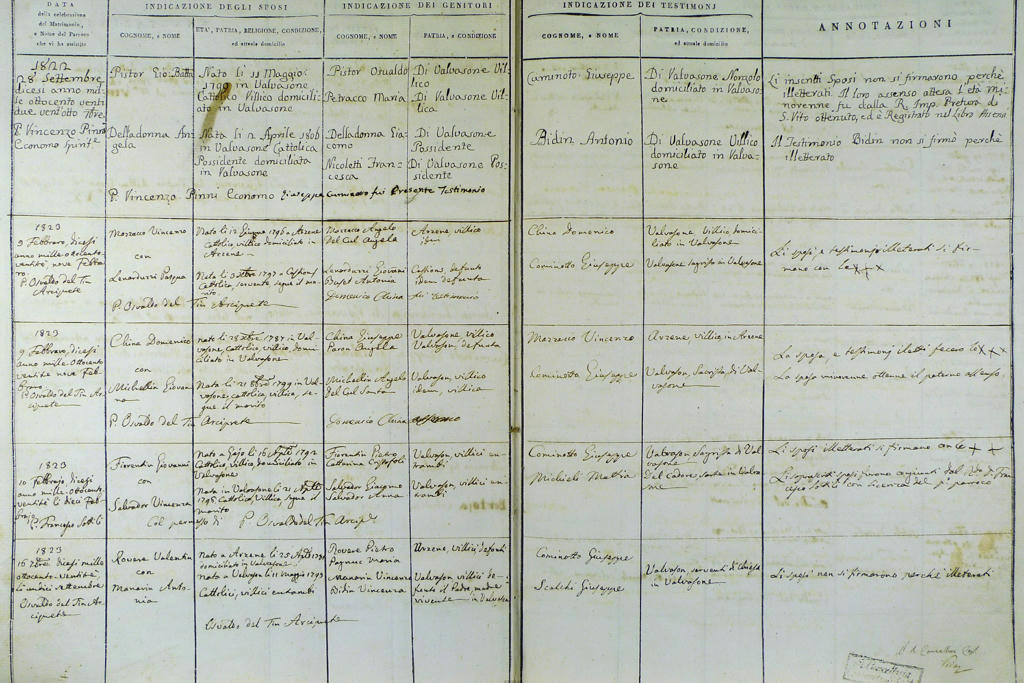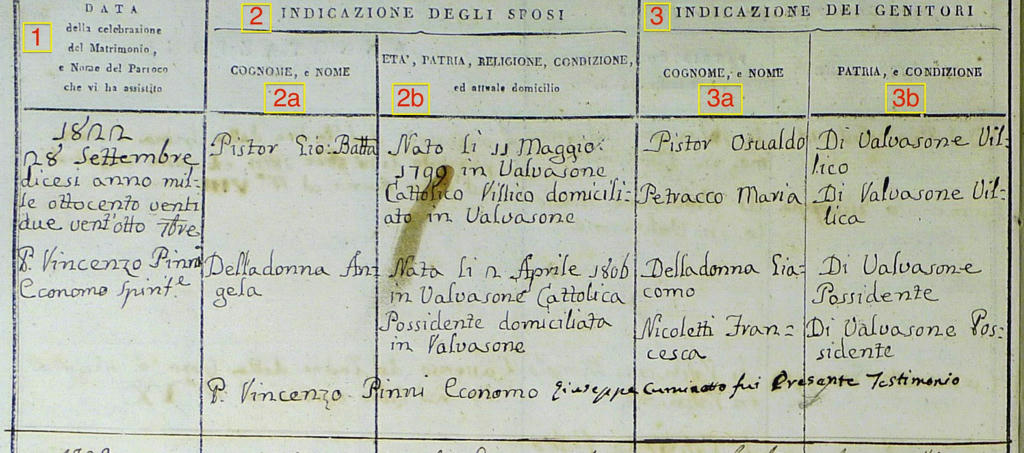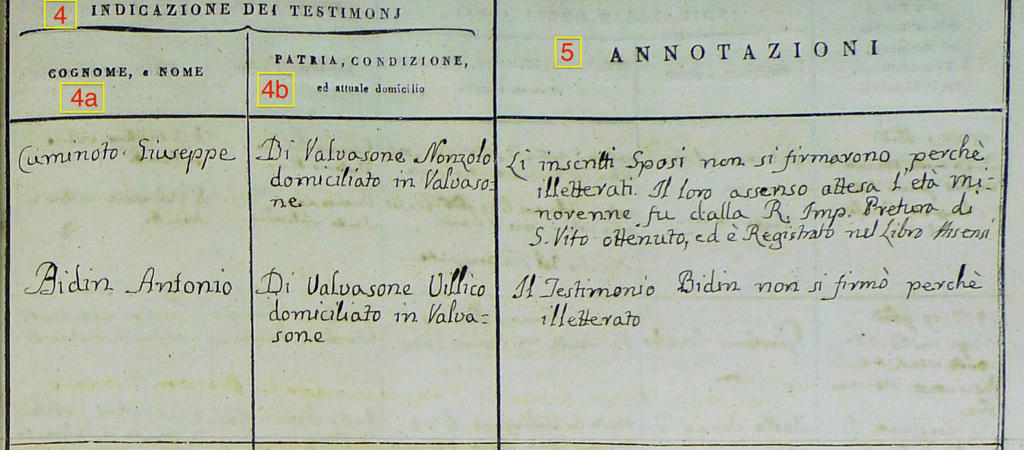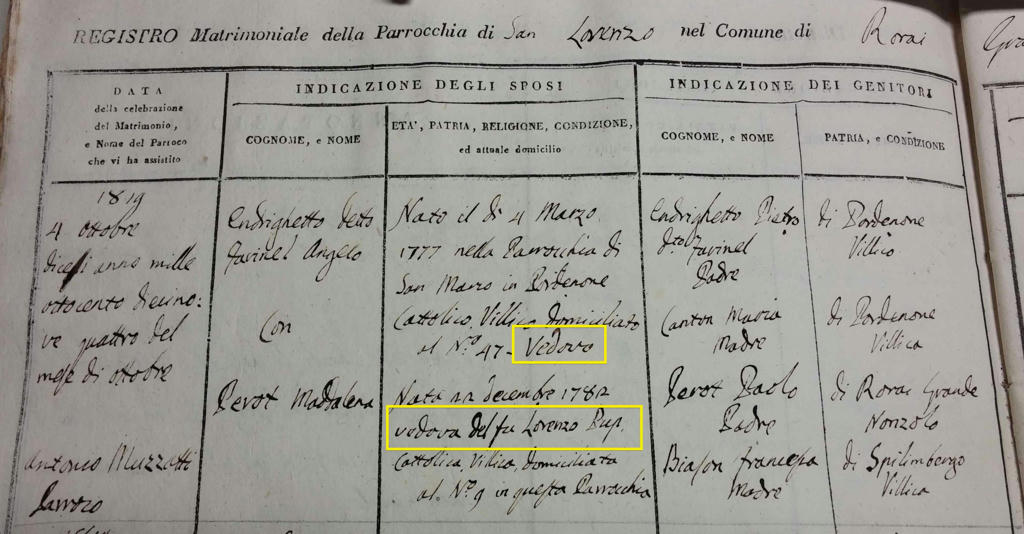I'm just going to do the same for the Marriage Registers, transcribing and translating the column headers and an example.
This is the a typical page of one of these books:
Parrocchia di Valvasone, Libro dei Matrimoni 1815-1863, copia digitale, pg. 25-26, Diocesi di Concordia-Pordenone, Archivio Storico, Pordenone
Zooming into the headers, on the left page we find:
Parrocchia di Valvasone, Libro dei Matrimoni 1815-1863, copia digitale, pg. 25, Diocesi di Concordia-Pordenone, Archivio Storico, Pordenone
Italian:
1- Data della celebrazione del matrimonio, e nome del Parroco che vi ha assistito
2- Indicazione degli sposi
2a- Cognome, e nome
2b- Età, patria, religione, condizione ed attuale domicilio
3- Indicazione dei genitori
3a- Cognome, e nome
3b- Patria, e condizione
English:
1- Date of the marriage and name of the priest who celebrated it
2- Informations about the groom and bride
2a- Surname and name
2b- Age, birthplace, religion, condition and actual domicile
3- Informations about the parents
3a- Surname and name
3b- Birthplace and condition
Some notes:
Sometimes, before N.1 there's another column with a progressive number.
Re 2b: Usually instead of the age we find the exact birthdate (see example).
Re 3b: Don't take the birthplace for the parents as a fact, because oftentimes it was just their town of residence.
So let's translate the left page of the marriage we see in that page, keeping in mind that you have to mentally divide (horizontally) the informations about the groom and the bride, that are written in the same row following their names.:
[Column 1] 1822, 28th of September [then they write it down in letters], Father Vincenzo Pinni.
[Column 2a] Pistor Gio Batta [groom] and Delladonna Angela [bride].
[Column 2b, top] He was born on the 11th of May 1799 in Valvasone, Catholic, Farmer, living in Valvasone, [column 3a and 3b, top] son of Pistor Osvaldo farmer from Valvasone and Petracco Maria farmer from Valvasone.
[Column 2b, bottom] She was born on the 2nd of April 1806 in Valvasone, Wealthy, living in Valvasone, [column 3a and 3b, bottom] daughter of Delladonna Giacomo, wealthy of Valvasone, and Nicoletti Francesca, wealthy of Valvasone.
[the line of names at the bottom are the priest and witness signatures]
I've translated the term "possidente" as "wealthy", it literally means "owner (of something)", but we don't know if it was land, a shop or what, although it often was land so it can be translated as landowner.
Let's do the same with the second page:
Parrocchia di Valvasone, Libro dei Matrimoni 1815-1863, copia digitale, pg. 26, Diocesi di Concordia-Pordenone, Archivio Storico, Pordenone
Italian:4- Indicazione dei Testimonj
4a- Cognome, e nome
4b- Patria, condizione ed attuale domicilio
5-Annotazioni
English:
4- Informations about the witnesses
4a- Surname and name
4b- Birthplace, condition and domicile
5- Notes
For this marriage, the witnesses were Cominoto Giuseppe, from Valvasone, sacristan, and Bidin Antonio, farmer, from Valvasone.
In the notes section it's written that bride and groom had not signed because they were illiterate, and that because they were minors they had obtained permission to get married. The witness Bidin Antonio was also illiterate and had not signed.
In the notes sections most often the priest simply recorded that the newlyweds or the witnesses were illiterate, but also that the couple had been dispensed from banns, or that they had received permission to marry from the bishop because they were cousins.
If one (or both) the newlyweds were widowed you may find it specified in column 2b, sometimes the name of the previous wife/husband is also recorded there.
See:
Parrocchia di San Lorenzo (Rorai Grande), Registro Matrimoniale 1815-1871, matrimonio del 4 ottobre 1819, p. sinistra, Diocesi di Concordia-Pordenone, Archivio Storico, Pordenone
In this case, both groom and bride were widowed, but for the groom we only have the word "vedovo", which means "widower", while for the bride we read "vedova del fu Lorenzo Pup" that translates to "widow of the deceased Lorenzo Pup", so we know her first (maybe!) husband's name.
I hope this helps!
The next one will be about death registers.




No comments:
Post a Comment